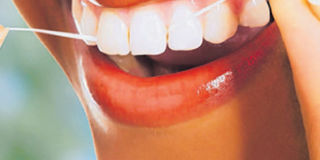Flossing: getting to know the answers to your questions

Daily flossing is highly recommended to prevent tooth decay and gum disease.PHOTO|THE CONVERSATION
What you need to know:
- While brushing your teeth twice a day is necessary for good dental health, at the same time flossing is also very important. Proper flossing removes plaque and food particles in places where a toothbrush cannot easily reach, that is, under the gum line and between your teeth.
Every time you visit your dentist, you remember the instruction of brushing twice but most of us ignore the very next instruction, which is flossing.
While brushing your teeth twice a day is necessary for good dental health, at the same time flossing is also very important. Proper flossing removes plaque and food particles in places where a toothbrush cannot easily reach, that is, under the gum line and between your teeth.
Because plaque build-up can lead to tooth decay and gum disease, daily flossing is highly recommended.
Why should I floss?
Cleaning between your teeth helps remove a sticky film called plaque. Plaque contains bacteria that feed on leftover food or sugar in your mouth.
When that happens, it releases an acid that can eat away at the outer shell of your teeth and cause cavities. Plaque that is not removed by brushing and cleaning between your teeth, can eventually harden into a rough substance called tartar (or calculus).
Tartar collects along your gum line and can lead to gum disease. Once tartar forms, only your dentist can remove it.
How often should I floss?
It is recommended that you should floss daily.
What’s the right way to floss?
To receive the maximum benefits from flossing, use the following proper technique:
• Starting with about 18 inches of floss, wind most of the floss around each middle finger, leaving an inch or two of floss to work with.
• Holding the floss tautly between your thumbs and index fingers, slide it gently up-and-down between your teeth.
• Gently curve the floss around the base of each tooth, making sure you go beneath the gum line. Never force the floss, as this may cut or bruise delicate gum tissue.
• Use clean sections of floss as you move from tooth to tooth.
• To remove the floss, use the same back-and-forth motion to bring the floss up and away from the teeth.
What if I develop bleeding gums?
Don’t worry if your gums bleed a little during the flossing process. Bleeding gums mean that they are inflamed because plaque has built up and needs to be removed. By flossing, you are treating this problem.
What kind of floss is right?
There are a few different types of floss in the market. Flosses are either mono-filament type or multifilament type. You can select the one according to the space in between your teeth in the case of tight contact; mono-filament type cleans easily and effectively. When used properly, both types of floss are excellent at removing plaque and debris.
Is it safe for children to floss?
Don’t forget, children need to clean between their teeth too. Start as soon as your child has two teeth that touch. Children usually are unable to do a thorough job on their own until age 10 or 11, so it’s better to assist them.
Keep in mind that cleaning between your teeth should not be painful. If you do it too hard, you could damage the tissue between your teeth. If you’re too gentle, you might not be getting the food out. It’s normal to feel discomfort when you first start, but don’t give up.
With daily brushing and cleaning between your teeth, that discomfort should ease within a week or two. If your pain persists, talk to your dentist.




